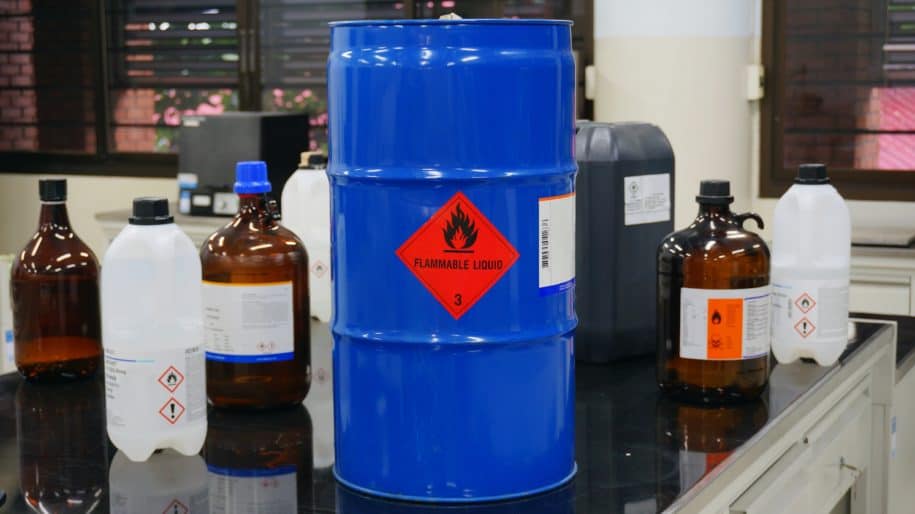Chemical safety is an important workplace safety concern for many reasons, as evidenced by several recent industrial accidents. For chemical safety, the knowledge of hazards, as well as easy access to information related to the chemicals for the employees at the workplace, is necessary. Proper communication, such as by simply labeling the chemicals used at the workplace, can aid in conveying the basic knowledge of physical and chemical hazards.
Labels are typically provided and readily available from manufacturers or distributors for new hazardous chemicals. However, labels are required when such chemicals are being moved to secondary containers. Managing these secondary containers plays an important role in the worker’s well-being and workplace safety.
What is a secondary container?
When the chemicals are transferred from the original container to another, these new containers are referred to as “Secondary Containers”. Secondary containers can be any container type such as flasks, buckets, or spray bottles. If these smaller containers are for immediate use, which are known as portable containers, then there is no need for labels. If the content in the secondary containers will not be immediately used and emptied, then additional labeling is required. Criteria for labeling the secondary containers are as follows:
- If a worker transfers the material and leaves the area
- When there is leftover material which is moved to another workplace
- When a transferred material is no longer under the control of the worker
Hazardous chemicals from the chemical manufacturer or distributors should provide labels on the primary container. As per the revised Hazard Communication (HazCom) Standard, all hazardous chemicals shipped should be labeled with specific elements. Labeling provides precise information about material handling, use, and storage. The following are the key labeling elements of hazardous chemicals:
- Name, Address and Telephone Number – Provides thebasic information related to the chemical.
- Product Identifier – Includes the data such as chemical name, CAS number, batch number, and manufacturer.
- Signal Word – Used to indicate the level of hazard severity. Usually, there are two signal words used in labels. “Danger” indicates a considerable risk and “Warning” indicates lesser severity.
- Pictograms – Represented in graph symbols with red squares, white background, and a black symbol in it. These symbols represent the flammability, corrosiveness, toxicity, and health hazards of the substance.
- Hazard statements – Specify the nature and degree of the hazard. These statements are precise to the hazard classification categories. Examples include: extremely flammable gas, causes eye irritation, may cause cancer.
- Precautionary statements – Inappropriate storing and handling of hazardous chemicals result in adverse effects. Precautionary statements aid to minimize or prevent the effects by providing the instructions related to the storage, handling, first aid, and recommended personal protective equipment.
In the case of secondary container labelling, employees are given the flexibility to create their labels. OSHA states that these labels should include “product identifier and words, pictures, symbols, or combination thereof, which provide at least general information regarding the hazards of the chemicals and which, in conjunction with the other information immediately available to employees under the hazard communication program, will provide employees with the specific information regarding the physical and health hazards of the hazardous chemical.” Besides GHS pictograms, it is also acceptable to use the NFPA 704 Diamond and HMIS labels on secondary containers.
Electronic Management
If any material is transferred to another container, then tracking the container, inventory and labeling can be difficult. It can consume considerable time and effort for any employee. Creating and neatly displaying labels for secondary containers based on the Hazard Communication (HazCom) Standard is necessary and can be a challenging job.
For better management of these transfers into secondary containers, digitization can help increase the efficiency and consistency of printing labels as per the requirement and also helps in tracking the container. Also useful is utilization of a barcode for a container, which provides the ability to quickly retrieve the complete details of the container on a single scan. In addition to an informative label to communicate hazards, digitization can even provide instant access to Safety Data Sheets (SDS) of every material used at the workplace.
Bottom Line
Employers must ensure that all the containers, including secondary containers, are labeled properly in order to communicate all potential hazards. Tracking and labeling secondary containers is essential for safety at the workplace. Adopting new technologies helps to track the secondary containers and allows for easy generation of printed labels based on the HazCom Standard, which increases both efficiency and efficacy of your workplace safety program.
For more details: Click here & Contact SafetyStratus Now
AUTHOR BIO

Satya is the resident Chemical Engineer here at SafetyStratus. She is focused on supporting and improving the Chemical Inventory and related products and services for the SafetyStratus platform. She has recently completed her master’s degree in Chemical Engineering. While relatively new to the business world, she has conducted cutting-edge research, participated in several notable projects, and worked at a refinery, a steel processing plant, and, most notably, for the Center of Atomic Research. She is eager to use her skills and talents to share knowledge with the broader EHS community.
Follow @Satya: Linkedin
References
Government of Canada, Canadian Centre for Occupational Health and Safety. (2015). WHMIS 2015 – Labels. Retrieved from Ccohs.ca website: https://www.ccohs.ca/oshanswers/chemicals/whmis_ghs/labels.html
United States Department of Labor. (2011). Labeling and Transfer of Chemicals. Retrieved from https://www.osha.gov/Publications/laboratory/OSHAquickfacts-lab-safety-labeling-chemical-transfer.pdf
United States Department of Labor. (2013). Hazard Communication Standard: Labels and Pictograms. Retrieved from https://www.osha.gov/Publications/OSHA3636.pdf
United States Department of Labor. (2017). Labeling of Secondary Containers. Occupational Safety and Health Administration. Retrieved September 14, 2020, from www.osha.gov website: https://www.osha.gov/laws-regs/standardinterpretations/2017-06-20



